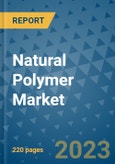The global natural polymer market, which had a market size of USD 8.1 billion in 2021, is anticipated to experience robust growth with a projected CAGR of 4.9 percent during the forecast period. Natural polymers, derived from animals, plants, and microorganisms, are gaining popularity due to their cost-effectiveness, non-toxic nature, and abundant availability in nature. They find applications across various industries such as construction, adhesives, paints & inks, pharmaceuticals, food & beverage, oilfields, cosmetics & personal care products, and packaging.
Driving Factors
The demand for natural polymers is driven by the increasing consumer preference for environmentally friendly and non-petroleum-based products. Commercially available plastics that are not biodegradable have caused environmental concerns, making the packaging industry a major adopter of natural polymers to reduce their carbon footprint. Additionally, the pharmaceutical industry is utilizing natural polymers for applications like binders and fillers for capsules, wound dressings, and treatments for joint ailments, further driving market growth.
Challenges
The natural polymer market may face challenges due to price fluctuations, raw material shortages, inconsistent product quality, and supply uncertainties. Moreover, strict regulations and growing awareness about deforestation and animal conservation could restrain market expansion. However, ongoing research and development efforts to explore innovative applications for natural polymers, particularly in medicine delivery strategies, offer growth opportunities.
Segment Overview
Among the different types of natural polymers, cellulose ethers are dominating the market, primarily due to their extensive application in biomedical science. Bacterial cellulose, with its good mechanical properties and high hydrophilicity, finds usage as a scaffold or membrane for tissue engineering, wound dressings, and drug delivery.
The packaging material category is leading the market as the demand for eco-friendly packaging materials rises. Natural polymers such as starch-blends and polylactic acid are increasingly used in various packaging products, responding to the consumer shift toward chemical-free and sustainable packaging solutions.
Regional Landscape
North America leads the natural polymer market, driven by applications in pharmaceuticals, cosmetics, personal care goods, packaging, and the oilfield industry. The rising demand for oil and gas, coupled with increased industrialization and population growth, fuels the market in the Asia Pacific region. Meanwhile, Europe witnesses healthy growth due to growing consumer demand for environmentally friendly products. The Middle East's expanding construction industry and the FIFA 2022 World Cup in Qatar contribute to the demand for natural polymers in the region.
COVID-19 Impact
The packaging sector's expansion was affected by the COVID-19 pandemic, leading to decreased demand for consumer products and subsequently impacting the food and beverage industry, where packaging plays a crucial role. The prohibition on overseas travel also resulted in fewer import and export transactions, further affecting the packaging sector. While the market for natural polymers may face temporary challenges due to these factors, the growing focus on sustainability and eco-friendly solutions is expected to drive long-term growth.
Global Natural Polymer Market: Competitive Landscape
In the dynamic and evolving natural polymer market, several key players are contributing to innovation and sustainable solutions. Here are some notable developments and players in the industry:
BMW I Ventures and Natural Fiber Welding, Inc. (NFW): In July 2021, BMW I Ventures invested in Natural Fiber Welding, Inc. NFW is a producer of plastic-free, all-natural alternatives to materials derived from animals or petrochemicals, including textiles, foams, and leathers. With the capital infusion, NFW aims to enhance its production capabilities, from batch material handling to industrial roll-to-roll production.
University of Cambridge - Plant Protein Polymer Film: Researchers at the University of Cambridge made a significant breakthrough in June 2021 by creating a polymer film entirely made of plant protein. The innovative material does not require any chemical additives and performs similarly to traditional polymers. The solution, known as Xampla, is fully biodegradable and can be disposed of in nature after use, leaving no pollutants behind. The plant protein used in the film is sourced as a by-product of the agriculture industry, making it an eco-friendly alternative.
American Regent, Inc., Vifor Pharma Group, Sandoz, and Mylan Laboratories Ltd.: In December 2021, American Regent, Inc., and Vifor Pharma Group announced settlement agreements with Sandoz, Inc. and Mylan Laboratories Ltd. related to the patent litigation concerning Injectafer®, an iron replacement therapy. This development may impact the natural polymer market as companies seek regulatory approval for generic versions of pharmaceutical products.
Leading Players: Among the prominent companies in the natural polymer market are Ashland Inc., Novamont S.p.A., Archer Daniels Midland Company, Dow Chemical Company, Economy Polymers and Chemicals, CP Kelco, Encore Natural Polymers, Akzo Nobel, BASF, Croda International, and Cargill. These players are actively engaged in developing sustainable and eco-friendly solutions to meet the growing demand for natural polymers across various industries.
The competitive landscape of the natural polymer market is driven by continuous research and development efforts to explore innovative applications and improve the environmental footprint of products. Companies are focusing on creating plant-based alternatives to replace petrochemical-derived materials and meet the rising demand for environmentally friendly and sustainable solutions.
Table of Contents
Companies Mentioned
- Kimica Corporation
- Ashland Inc.
- Cargill Inc.
- CP Kelco U.S., Inc.
- Hindustan Gum
- SNP, Inc.
- Java Biocolloid
- ENCORE Natural Polymers Private Limited
- Metabolix, Inc.
- Nouryon
- RWDC Industries
- Nanjing Shineking Biotech Co., Ltd.








